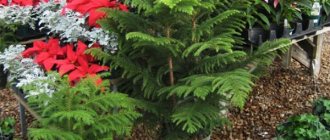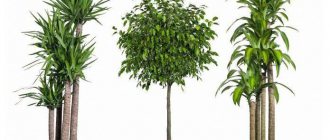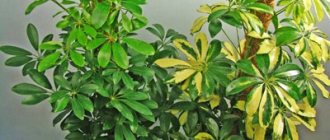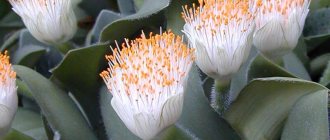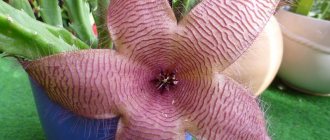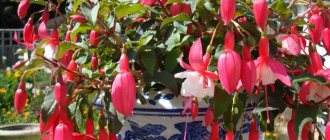The decorative deciduous perennial acalypha (Acalypha) is part of the Euphorbiaceae family. This flower has two forms: an ampelous plant and a shrub. It is native to New Guinea and Malaysia, where it is found in tropical forests. In nature, some varieties can reach a maximum height of about 200 cm. However, domestic akalifa, as a rule, has a maximum stem length of about 100 centimeters.
The shoots are characterized by increased flexibility, and they are decorated with oval or lanceolate leaf plates, and their color can be very different: from brownish-red to greenish. The cascading long spike-shaped inflorescences consist of small red-crimson flowers. If you provide the plant with optimal growth conditions and suitable care, then it will bloom all year round.
Akalifa is a fast-growing plant that is quite easy to care for. In order for the bush to look neat and bloom magnificently, we must not forget to promptly trim the flowers that have begun to fade.
Brief description of cultivation
- Temperature . In the warm season, the optimal air temperature for akalifa is around 23 degrees. And in winter it should be within 15 degrees.
- Air humidity . Requires high air humidity (minimum 50 percent). At the same time, you can moisten the bush with a sprayer only during the growing season (excluding flowering time).
- Illumination . The place should be well lit, the light diffused. In the shade, the foliage becomes faded, and when direct rays of the sun hit its surface, burns form.
- Watering . Moisten the substrate systematically. In summer - at least 2 times every 7 days, and in winter - immediately after the top layer of the soil mixture has dried.
- Substrate . It should allow water and air to pass through well, and also be nutritious. You can use ready-made soil mixture purchased at a specialty store. If desired, you can make it yourself: combine peat, sand, turf soil and humus.
- Fertilizer . During the growing season, Akalifu is watered with a nutrient solution twice or thrice a month. To prepare it, take a liquid mineral complex for house plants.
- Transplant . In spring or summer. In adult large bushes, instead of replanting, you can simply annually replace the top layer of substrate in the pot with a new soil mixture.
- Reproduction . In spring, by seed or apical cuttings.
- Trimming . To ensure that the bush is always neat and impressive, both sanitary and formative pruning is carried out every year: all stems are shortened by ½ of their length. Once every 3–5 years, anti-aging pruning is carried out: the bush is shortened to 20–30 centimeters.
AKALIFA or FOXTAIL | Care and breeding at home
Description of the Akalifa plant
Representatives of the genus Akalifa are evergreen, beautifully flowering shrubs and herbaceous perennials, and less commonly trees.
There are two groups of foxtail species:
The most common of them have pubescent, pointed, ovate, serrated edges, bright green leaves. They bloom with beautiful bright red fluffy drooping spike-shaped inflorescences, reaching a length of up to 50 cm, with long flowering. This group of species is grown for the sake of beautiful inflorescences.
The second group of foxtail species is grown for their bronze-greenish, with bright copper-red spots, ovoid, serrated along the edge, pointed leaves, reaching a length of up to 20 cm. They bloom with small, up to 5-10 cm long, red flowers collected in inflorescences.
The homeland of this rather unusual plant is the tropics of Southeast Asia, Australia, and Polynesia. The very original color of the leaves and the beautiful spike-shaped inflorescences of Akalifa made it a popular plant in indoor floriculture. The Latin name for foxtail, “akalitha,” comes from the ancient Greek name for nettle: based on the similarity of the leaves.
While all the attention is attracted by the short-lived, rather capricious, but at the same time suitable even for beginners akalifa bristly (bristly-haired) or fox tail, other species are undeservedly ignored by gardeners. One of the special acalyphas is a plant previously known as creeping acalypha , or Spanish acalypha , or Haitian foxtail , today finally officially renamed to oak-leaved acalypha (Acalypha chamaedrifolia). It stands out with its lushness, grace and small leaves in cloud-like lace pillows. This is a pleasant alternative to the classics and a very joyful plant that brings excitement to any room.
On a note! The genus Akalifa, or foxtail (Acalypha), includes about 450 species of ornamental flowering and ornamental foliage plants of the euphorbia family (Euphorbiaceae).
Akalifa oakleaf, in contrast to the classic foxtail, is grown mainly in ampels. Its flexible shoots beautifully spread, bend and tangle, creating a lush, thick, spreading cushion, and seem lace-curly. Unlike foxtail, this akalifa has dense branches and is much more compact; the bushes are only 30 cm high. But there is no need to rush to plant this type of akalifa only in hanging baskets. It also looks great in a flowerpot, hanging a little over the edges. And in winter gardens it can even be used as a ground cover.
Akalitha, or foxtail.
The length of the leaves of this species of akalifa will not exceed 4 cm, which makes them stand out pleasantly against the background of the familiar large-leaved foxtail. So the epithet “small-leaved” is more than suitable.
Heart-shaped, elongated in shape, with a jagged edge, pubescent-velvety, soft leaves sit alternately and surprise with their light, warm, pleasant medium green tone. The shades of color, as well as the shape of the leaves, in creeping akalifa evoke associations either with lemon balm or with catnip.
Dense velvety spikelets droop on thin long stalks, only when they bloom and grow, they stick out funny upward and bend slightly, which gives them a pepper-like shape. The length of the inflorescences does not exceed 10 cm, most often being limited to only 4 - 5 cm. Their coloring is always typical - a bright dark crimson shade of cool red seems dazzling and elegant. The inflorescences look heavy, and their drooping shape creates the illusion that the branches cannot support their weight.
In Akalifa oakleaf, the duration of flowering depends on the lighting. If the plant is comfortable, it does not stop blooming all year round, but usually, even in the optimal location without additional lighting, flowering cannot be achieved for longer than 8-9 months.
Like all acalyphs, oakleaf is a poisonous species. When working with plants or growing them in homes with small children and curious pets, you need to be careful.
Acalypha chamaedrifolia.
Caring for Akalifa at home
Bloom
Indoor akalifa can bloom at any time of the year or even all year round. Spike-shaped fluffy inflorescences are collected from a large number of small red-crimson flowers. In some varieties, the length of the inflorescence can reach up to 50 centimeters.
In order for the plants to always look attractive, we must remember to promptly pick off the inflorescences that have begun to fade.
Temperature
Akalifa prefers to be warm. In the spring-summer period, the optimal air temperature is from 21 to 25 degrees, and in the cold season - from 12 to 16 degrees. If the room is too hot, this will lead to the shoots stretching and the plant losing its decorative properties. If the room has the minimum permissible air temperature, this may cause the growth of the bush to slow down and the development of various diseases. In addition, drafts pose a particular danger to akalifa. In this regard, under no circumstances should it be moved outside, even in the summer.
Air humidity
Since Akalifa is a tropical plant, it needs constant high air humidity. During the growing season, it is recommended to systematically spray the bush with a spray bottle. In this case, it is the air around the plant that needs to be humidified, and not its foliage. To do this, use well-settled, non-cold water. It is impossible to moisten the plant during the flowering period.
Illumination
This plant is distinguished by its high sensitivity to light, despite this, it requires mandatory protection from direct rays of the sun. The bush will feel best on a windowsill with an eastern or western orientation. It can also be placed on a south window, but in this case it will have to be additionally protected from direct rays of the sun. Akalifa cannot be grown in a shaded place, as this will cause its stems to become elongated and the leaves to become small and faded.
Watering
Watering should be systematic and moderate at any time of the year. Remember that you should not allow the earthen ball in the pot to dry out. It should be taken into account that on hot summer days the substrate in the pot dries out much faster. In the winter months, the frequency and abundance of watering should be slightly reduced.
Choosing a pot
The plant feels great in a pot where its root system is quite crowded. But at the same time, do not rush to purchase an excessively small pot for Akalifa, as this will only harm her. The root system should fit normally into the selected container and have a small amount of space for further growth.
soil mixture
This flower grows well in almost any soil mixture, as long as it is well-drained and light. An earth mixture consisting of leaf and turf soil, humus, peat and sand, which should be taken in equal parts, is best suited for its cultivation.
Top dressing
Akalifa must be fed from the first days of spring until mid-October. To do this, use a mineral complex, which is added to the soil mixture once every 15–20 days. The plant can also be regularly fed with organic matter. For example, you can use vermicompost.
Akalifa transplant
While the bush is young, it grows very quickly. In this regard, it needs regular transplants into larger pots, which are carried out once a year. It is recommended to replant adult specimens no more than once every 3 or 4 years. In this case, old large bushes, if necessary, are transplanted by transferring them into a larger container, or simply systematically replace their top layer of soil mixture with a new substrate.
Trimming
In order for the bush to always be neat and impressive, formative pruning should be carried out annually in spring. To do this, cut off all the stems, leaving ½ of their length (a little less is possible). If necessary, the plant can be rejuvenated; to do this, all its shoots are shortened to 0.2–0.3 meters. In order for young shoots to appear on the stumps as soon as possible, it is recommended to treat them with a Zircon solution.
Rest period
Akalifa growing indoors develops normally even without a full dormant period. A decrease in daylight hours can signal to the bush that it is time to rest. Such a mild dormant period does not last long, and it will require stopping the application of fertilizing, as well as reducing the frequency of watering.
The best types of indoor akalifa
Akalifs, which got their name due to the shape of their leaves, similar to nettles, are lovingly called cat or fox tails by flower growers. But not all of the acalyphs can boast of “fur” inflorescences: along with beautifully flowering plants, this family also has a whole group of species whose leaves are the most attractive. Of course, “fox tails” are more popular, but today on the shelves you can find a huge assortment of decorative deciduous acalyphs. The plants are united by the shape of pointed-oval leaves, different in size, but always decorated with teeth along the edges, and unusual inflorescences, reaching half a meter in length in some species.
Akalifa oakleaf.
The fluffiest inflorescences that actually resemble “tails” are characteristic of Acalypha oak-leaved, often listed on sale as Haitian or Spanish. In nature, this is a creeping ground cover; in indoor cultivation, it is an elegant hanging plant, whose flexible, drooping shoots form a lacy crown. Lacy, translucent and surprisingly elegant bushes up to only 35 cm high are surprisingly lush thanks to the dense branching of the shoots. The leaves of this akalifa are small, only up to 4 cm, with a typical jagged edge and are very bright, giving the whole plant elegance. But the fluffy spikelets with a thick “fur” edge, drooping, only up to 10 cm in length and up to 3 cm in thickness are what attract everyone’s admiration.
Akalifa hispida, bristle-haired or “fox tail” attracts primarily with its inflorescences. In indoor culture, only female plants are used, whose velvety drooping inflorescences resemble fur lashes of bright red-purple color. They reach half a meter in length and hang elegantly between large leaves.
Akalitha hispida, bristly-haired.
A distinctive feature of “foxtails,” two beautifully flowering species of acalypha, is the ability to bloom literally all year round. The plant does not pause if the growing conditions are chosen correctly and is always decorated with luxurious inflorescences, which makes it an almost indispensable accent in the interior. Today you can find snow-white Alba forms on sale.
Akalifa Vilkez is one of the most fashionable decorative foliage plants. It has many forms with a variety of leaf colors, while the richness of silhouettes, sizes, and structural features also amazes the imagination.
The flowering of Akalifa Vilkez is non-standard, and although not as beautiful as that of the “fox tail,” it is also attractive: the inflorescences seem to be long threads or lashes, gracefully hanging between the leaves. Akalifa Vilkez has original varieties with curved or curled leaves, uneven spots and variegated patterns. This is an evergreen plant whose leaves reach 20 cm in length (and only slightly less in width).
Akalifa Vilkez 'Hoffmannii'.
Akalifa Godsef, which have undergone hybridization, flaunt no less variegated, but narrower, lanceolate leaves. They are often decorated not with asymmetrical spots, but with a border, copper, bronze, and golden stripes, emphasizing the jagged edge of the leaves. Particularly fashionable is the multi-leaved form, in which the green color of the leaves changes to red in bright light, and this “changing of clothes” does not immediately cover the entire crown, but only some leaves. As a result, it seems as if the plant is very variegated and colorful.
When purchasing any akalifa, be prepared for the fact that the plant will change its appearance and become more straggly, large and sloppy. The thing is that in nurseries akalifas, especially foxtails, are most often treated with growth inhibitors, but at home they gradually restore their natural forms and do not at all look like ideal bushes. But active (and sometimes rapid) growth is not a minus at all: akalifas are so unconventional that they can surprise you with the beauty of their crowns.
Akalifa Godsefa.
Akalifas are relatively new indoor plants for us. They are classified as indoor exotics, but today they are represented by a huge assortment of different types and varieties. For some, acalyphs attract more attention to the leaves, while for others, the inflorescences evoke universal admiration. It was the “fox tails” of the akalifa of the same name that became the symbol of the entire clan. But other acalyphs also deserve active use in the interior. After all, these are not demanding beauties, content with modest care, who will become a bright accent in the design of rooms.
Reproduction methods
Growing from seeds
Homemade akalifa can be grown from seeds. To do this, they are sown in a light and loose substrate consisting of sand and leaf soil. For the rapid emergence of seedlings, crops must be provided with an optimal temperature for growth: from 20 to 22 degrees. To maintain the required temperature and humidity, it is recommended to place the crops in a mini-greenhouse. In this case, seedlings will appear much faster.
After the plants reach a height of 20 to 30 mm, they are planted in individual cups. Then they are cared for in the same way as adult akaliphs.
Cuttings
Any type of akalifa can be propagated by cuttings. However, there is one important rule: acalypha bristly-hairy can be propagated in this way only in spring, and variegated varieties can be propagated throughout the year. For rooting, the cuttings are placed in a mini-greenhouse, and they are planted in a loose mixture of sand and peat.
Before planting for rooting, it is recommended to treat the lower part of the cutting with a product that stimulates root growth. The cutting quickly takes root and begins its intensive growth. After 6 weeks after planting the cuttings, you should pinch their upper parts so that the bushes grow more luxuriant.
Akalifa cuttings and dividing the bush.
Growing conditions for indoor akalifa
Akalifa oakleaf is so thermophilic that a drop in temperature to 15-16 degrees, even in winter, can be perceived as great stress. The plant reaches its greatest decorative value in stable heat - a temperature from 17 to 21 degrees, at which the leaves grow thicker, the colors are brighter, and even the flowering period is pleasantly surprising. If the temperature exceeds 23 degrees, it is better to ventilate more frequently. The plant is not particularly sensitive to drafts, but it is still better not to expose the lush cushions of akalifa to sudden temperature changes when ventilating.
Like all its relatives, Spanish Akalifa is sensitive to direct sun. But lush, uniform flowering throughout the entire crown is characteristic of it only in sufficiently bright lighting. It is better not to experiment with shading, choosing western or eastern window sills (and similar locations with diffuse lighting). You can make Akalifa bloom all year round with the help of timely installed additional lighting or moving it to a south window.
Uniform flowering of oak-leaved acalypha is characteristic of it only in sufficiently bright light.
Possible problems
Indoor akalifa is distinguished by its undemanding care and growing conditions, as well as its endurance. But if the bush is in unsuitable conditions or is not provided with proper care, this can lead to various problems or the appearance of pests.
Common problems:
- Yellowing and flying of leaves . The bush feels an acute lack of moisture, so you should immediately adjust the watering regime. If nothing is done, this will have an extremely negative impact on the appearance of the plant.
- Leaf blades wither and die . Most likely, the room is very cold. To correct the situation, move the flower to a place where the air temperature will be optimal for it.
- The foliage becomes faded . This indicates that the substrate has too little nitrogen. Fertilize with the necessary fertilizer.
- Slow bush growth . This problem is associated with a lack of nutrients in the soil mixture. It can be solved by systematically adding fertilizer to the substrate.
- Brown spots on foliage . This suggests that Akalifa is sick with a fungal disease. To save it, you should treat it with a fungicide.
Most often, the following pests settle on such a plant: scale insects, mealybugs, aphids and thrips. To get rid of these pests, spray the bush with an insecticide solution.
Diseases and pests
Akalifa is hardy and undemanding to growing conditions, but if the rules of caring for the plant are significantly violated, it can be susceptible to disease and attack by pests. Inexperienced gardeners face the following problems
- Akalifa leaves turn yellow and fall off - the plant does not have enough moisture, it is necessary to urgently eliminate watering problems, otherwise the flower will completely lose its decorative effect;
- The leaves of the akalifa wither and fall off - probably the room where the plant is located is too cold. To restore your flowers to a healthy appearance, move them to a temperature-controlled room;
- Pale leaves indicate a lack of nitrogen in the soil, so the plant should be fed with appropriate fertilizer;
- Akalifa grows slowly - this is also due to a lack of nitrogen and other important micro- and macroelements. This problem can be solved by regular fertilization;
- brown spots on the leaves of akalifa are evidence of infection of the plant with a fungal disease; to stop its spread, the flower is treated with a suitable fungicide.
Pests that pose a real threat to Acalifa are aphids, lepidoptera, thrips and mealybugs. Special insecticides for indoor plants help effectively combat them.
Types of Akalifa
Acalypha wilkesiana
This variety was obtained artificially by breeders. The plant has straight stems that become woody over time. They contain large simple leaf plates shaped like a heart or an oval. Spike-shaped inflorescences consist of small reddish-crimson flowers. This akalifa differs from the others in its unusual foliage color, which can vary from speckled brown to greenish.
The variety has 2 forms:
- Godsefa (Godseffiana) . On the surface of the dark green leaf blades there is strong pubescence, and along the edge there is a golden border.
- Mosaic (Musaica) . Large brownish-red leaf blades are decorated with small spots of dark color.
Acalypha hispida
Akalifa bristle-haired, or Akalifa bristly, or red cat's tail.
The species is represented by shrubs. Its foliage is rich green, and its spike-shaped inflorescences can reach about 50 centimeters in length. This type of kalifa is the most popular among flower growers.
Haitian acalypha or cat's tail (Acalypha hispaniolae)
This hanging plant has thin flexible stems reaching approximately 0.3 meters in length. The dark green oval leaf blades have a serrated edge. Red flowers are part of short fluffy spike-shaped inflorescences.
Types and varieties with photos
Akalifa has been grown as an ornamental crop since 1898. There are more than 400 species of plants. Breeders have developed a variety of varieties that are suitable for growing at home. The most popular of them is Akalifa bristle-haired. Akalifa variegata, Wilksa, Wilkesa and other varieties are often found.
Bristly haired
Thanks to this variety with its characteristic red spikelet inflorescences, Akalifa received the second name “foxtail”. There is a variety of alba, distinguished by white fluffy inflorescences. In indoor conditions, the crop grows up to 80 cm. With proper care, foxtail can bloom all year round.
Variegated
Akalifa variegata has large pointed foliage of original color: light leaves are covered with yellow or white spots of different sizes and shapes. The culture blooms with light green flowers, collected in spike-like inflorescences, throughout the year.
Wilks
The plant is often used in interior decoration and landscape design because it has bright copper-red or green foliage with speckles of purple or red. During the flowering period, small red flowers appear at the tops of the branches, which are collected in spike-shaped inflorescences. In favorable living conditions, the height of Wilks' akalifa reaches 1.8 m (in the garden).
Vilkez
The evergreen plant is characterized by wide leaves of green or bronze color with copper-red spots. The shape of the latter is oval with pointed ends and jagged edges. This akalifa variety has small reddish inflorescences that are almost invisible in the foliage.
The benefits and harms of Akalifa
Benefit
If you want to improve the environmental situation in the room and apartment as a whole, then you should pay attention to Akalifa. It can normalize electrostatics, as well as clean the air from pathogenic microorganisms and fungi. In addition, the akalifa bush helps to stabilize the positive energy in the room, and it also has the ability to have a calming effect on the person in the room.
Useful properties of Akalifa
Growing akalifa indoors will improve the environmental condition of the room. This reduces the amount of harmful microflora and normalizes electrostatics. In addition, the presence of a plant in an apartment stabilizes the positive energy of the environment and has a calming effect on the inhabitants of the room.
Watering
During the period of active growth and flowering, the plant needs regular and abundant watering. Watering should be done with boiled or settled water. The next watering is carried out only if the soil on top has already dried out. With the onset of winter, watering is reduced slightly. Periodically, the flower is sprayed with a spray bottle.
Akalifa needs high air humidity, at least 60-70%.
To increase air humidity, it is recommended to use electric humidifiers or fountains.
Pruning akalifa
This plant quickly loses the beauty and compactness of its bushes, actively develops and often “falls apart”. Therefore, it is better to trim the akalifa regularly, forming or maintaining beautiful silhouettes. The best time for pruning is spring, before replanting. Shorten the longest shoots and pinch out the tops of stray branches.
In addition to the actual formative pruning, you will need acalife and timely removal of fading inflorescences. The thing is that Akalifa's pedicels are already sticky, and fading flowers become a kind of magnet for rot and dust. You also need to promptly remove dry or wilted leaves from the bushes.
Acalypha godseffiana heterophylla.
Akalifa Wilkesiana (Acalypha wilkesiana).
Carefully monitor your plants: acalyphs in indoor culture, especially if they have been restrained in growth, are prone to degeneration, overgrowth, and at the first signs of oppression it is necessary to carry out radical rejuvenation. Branches up to 25 cm long are left on the bushes, weak and damaged ones are cut out, and the tops of the shoots are used for cuttings. Recovery will require patience: the mother plant will initially show no signs of growth for a long time, but then will quickly and actively begin to take root.
Frequency of replanting : only as needed, after the soil is completely filled with roots. Transplant time : spring, at the very beginning of active growth. Substrate : light, air- and water-permeable (an earth mixture of equal parts of high-moor peat, leaf soil, turf soil and sand is best suited).
Why is Akalifa sick?
The main problems are lack of humidity, heat, nutrients and overwatering.
| Problem | Causes | How to fight | Prevention |
| Inflorescences do not form | Not enough light, heat, nutrients | • Transfer to a bright room with a temperature of 16-21 °C. • Fertilize 2 times a month | • Avoid hypothermia. • Use artificial lighting in winter. • Fertilize regularly |
| The leaves are drying up | Dry air | Trim damaged leaves | • Spray more often. • Keep a cup of water nearby |
| The leaves drooped | The soil dries out excessively between waterings | • Water well. • Cover the short plant with a plastic bag | Water regularly from March to October. |
| Healthy leaves turn pale and wither | • Overflow. • Insufficient drainage. • Soil too heavy | Replant the plant in new soil | • Use a light, loose mixture. • Do not cover the drain hole. • Water according to the season. |
| The flowers are rotting | Humidity too high | • Remove damaged flowers. • Improve ventilation in the room | • Do not spray flowers. • Ventilate the room |
| Foliage becomes covered with dark spots | Too cold or drafty | • Cut off deformed leaves. • Move to a warm room | Protect from cold and drafts |
| The leaves grow small and pale, the bush branches poorly | • Not enough nutrients. • The root system has outgrown the pot | • Fertilize the plant. • Transfer to a larger pot | Fertilize regularly from spring until the end of flowering |
| After transplantation, the young plant does not produce new shoots | The pot is too big | Transfer to a pot no larger than 13 cm | Select a pot proportional to the size of the plant |
| The two-year-old bush has a sparse crown and long internodes. | The plant is not formed | Shorten shoots to 30 cm from the soil surface | Form a bush annually at the beginning of the season |
Diseases, pests and problems in growing akalifa
Akalifa oakleaf often suffers from pests - aphids, whiteflies, spider mites. It is not easy to notice pests in the lush leaves of a plant even with careful examination, so you should immediately respond to its depressed state and signs of damage - deformation due to aphid infestation, discoloration due to whiteflies and spider mites. On this type of akalifa, it is better to immediately remove the damaged parts and treat the bushes with insecticides or infusions of medicinal herbs (tobacco, dandelion, onion).
Cuttings of Akalifa oakleaf are most often rooted.
Lighting and temperature
A suitable place for the flower will be on the east or west side of the house. The plant should be positioned so that it is not exposed to the bright, midday sun. You can place Akalifa deep in the room, where there is mostly diffused light. When choosing a place for a plant, it is also necessary to take into account that the plant is poisonous and does not tolerate drafts. Akalifa is a rather heat-loving plant. The room temperature should be +21-25 degrees.
Pests
The first thing you need to do to keep the plant pest-free is to care for it properly. It is also necessary to carry out preventive measures to reduce the risk of infection with akalifa:
- newly purchased plants must be quarantined for some time;
- the room should be regularly ventilated, but so that there are no drafts;
- all indoor flowers should be carefully examined through a magnifying glass once a week;
- For akalifa to be healthy, air humidity and temperature are very important;
- You need to water the flower according to all the rules and apply fertilizers on time;
- When replanting, you need to be very careful not to damage the plant. Use only sterile instruments and process the sections;
- the soil and pots must be disinfected;
- The plant needs to be washed periodically in the shower. You can do this with soap foam.
Possible problems in the development of akalipha caused by improper care
- leaf falling in extremely dry air;
- wilting of leaves due to improper watering or in too dense a substrate;
- loss of color in poor lighting;
- drying of leaf tips due to insufficient watering or low air humidity;
- dark spots on leaves at low temperatures.
Brown weeping spots appear on the leaves:
- This may be due to leaf spotting.
Withering leaves:
- The reason may be overdrying or waterlogging of the earthen clod. Adjust watering. Another reason could be that the substrate is too heavy. Replace the substrate with a more suitable one.
The leaves lose their color and the leaves turn pale:
- The reason may be a lack of light. Adjust the lighting. If the plant has been in the shade for a long period, then it must be accustomed to more light gradually. In winter, illumination with fluorescent lamps is desirable.
Dry brown leaf tips:
- The cause may be too dry indoor air or lack of watering.
Dark spots appeared on the leaves:
- The cause may be hypothermia or drafts. Another reason could be illness.
Damaged by: spider mites, whiteflies and aphids.
Akalifa propagation methods
1. Apical semi-lignified cuttings, which can be collected during spring pruning from beautiful flowering plants and throughout the year from decorative deciduous plants. For rooting, greenhouse conditions with bottom heating and a temperature of at least 22 degrees are required. Young plants must be pinched a month after rooting, removing buds at the top of the shoots, and they are gradually adapted to bright light.
2. Seeds that are sown in early spring in a substrate of soil and sand in equal parts. At an air temperature of 20 cm with lower heating and under a hood, they germinate quite well. Akalifa seedlings are cared for in the same way as ordinary seedlings.
3. By air layering, by wrapping the shoot with damp moss in September and separating young acalyphs in early spring.
Transfer
Replant the plant only if absolutely necessary. Replanting is best done in the spring. Young specimens are replanted once a year, adults once every 3 years. Adult plants need to renew the top layer of soil every year. The pot for replanting should be wide and stable, slightly larger in size than the previous one. You should carefully remove the plant from the old pot and inspect all the roots; if you notice rotten ones, they must be removed. After preparation, Akalifa is placed in the center of the pot and covered with ready-made soil on top. After transplantation, the flower is watered.

